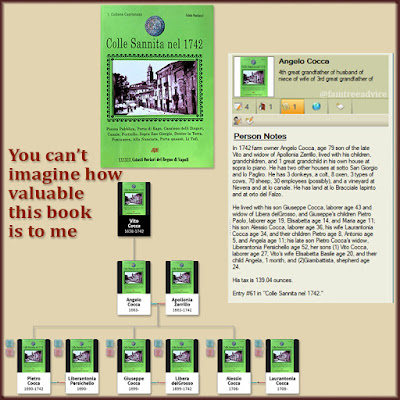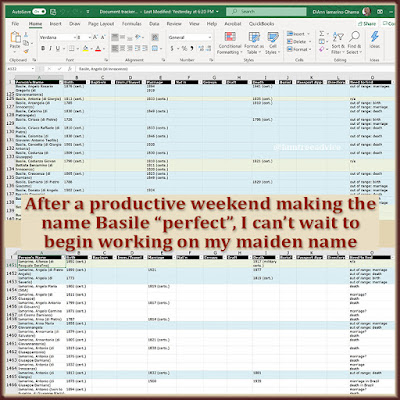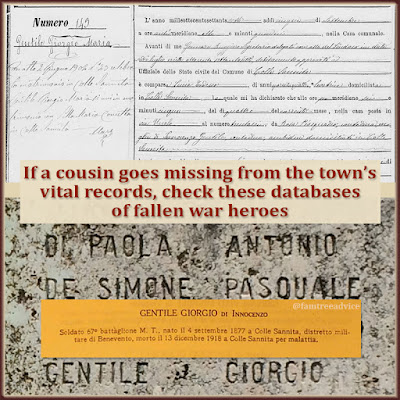I love when people tell me they aren't Italian, but my advice helps with their genealogy research. I try to keep my articles generic. But since I'm all Italian, I have to use Italian examples as illustration.
I've avoided writing about my new favorite genealogy treasure. It makes my heart swell every time I use it. But it's so specific. Not only to Italian ancestry, but to my grandfather's hometown. (Oh boy, here she goes again with Colle Sannita.)
Indulge me, though, because you will wish you had one of these for your ancestral hometown. And some of you may. At the bottom of this article are 46 Italian towns with a similar book.
Years ago a man found my post on an Italian message board devoted to my grandfather's hometown. That man, Dr. Fabio Paolucci, came from Grandpa's town, and is a local historian. He told me my maiden name of Iamarino is one of the original names from the town of Colle Sannita. Sometime later, he gave me my paternal family tree, dating back to the year 1690.
At that time, Italian vital records were not online. And Italian church records (from my area) are still not online. So Fabio provided me with something that was impossible for me to get on my own.
He pored over the oldest records from the town, piecing together hundreds of families. I knew he was writing a book, but I didn't know what it would contain. Until I finally got my hands on "Colle Sannita nel 1742" (nel means in).
Like a census, Italian towns produced a register (catasto) of every person in their town. This register lists the assets owned by the head of household. From individual plots of land to the number of sheep and mules. Based on their assets, the town calculated each household's tax.
This register also lists the names, ages, and occupations of each member of the household. In the book, I have the names, ages, and assets of each family living in my grandfather's hometown in the year 1742!
 |
| This detailed description of each household in my ancestral hometown is the best genealogy tool ever! |
My family tree already contained a good number of people born in the 1700s. But this book is helping me form their families and nail down each person's year of birth. That's invaluable! I'm also getting a better idea of life in these early years. Many of the households owned several plots of land, including many vineyards. Most families owned their own home. Several households included a man and his immediate family, his widowed mother, and his siblings and their families.
There were 560 households in town in 1742. I'm up to #343, looking for each family in my tree. If I find a match:
- I add the names, ages, and occupations of each member of the family.
- I give each fact a source I created for the book, including a photo of the book cover.
- I make the book cover the profile photo for each person, unless they already have a document as their photo. In that case, I add the book cover to their collection of images.
This makes it easy to track everyone I found in the book. In Family Tree Maker, I can view the image and see that I've identified 406 people from the book so far.
This past weekend I followed my own advice to make one thing perfect in my family tree. I worked my way through everyone in my tree with the last name Basile (bah-ZEEL). I found each person's available vital records within my collection of the town's records.
Then I turned to my new favorite book and found 13 people named Basile to document in my family tree. (There are more, but I can't fit them into my tree yet.)
It was such a rewarding weekend. I chose Basile because it was the first Colle Sannita name early in the alphabet that came to mind. Halfway through I thought, "why didn't I start with my maiden name?" So that's what I'll do next. I'll find all the available vital records for everyone name Iamarino in my family tree. And I'll use the Colle Sannita book to find even more details about those alive in 1742.
 |
| I worked through everyone in my family tree with one name, and completed their records and source citations. |
If you do have Italian ancestry, check the list below for your towns. I found these by searching for "catasti" on the publisher's website. I bought my book online using PayPal, and they shipped it quickly. The books sell for 30 Euro, but with shipping, it was more than $60. Still, the best money I ever spent.
Town registers available from the same publishing company are:
|
Acerra Aiello Casale di Atripalda Altavilla Apice (I need that one!) Atripalda Avellino Bonito Caggiano Calabritto Carovigno Caserta Castelpagano Castelvolturno Cervinara Colle Sannita Conza |
Foiano Gesualdo Guardia Itri Lapio Lentace Marzano Massa Lubrense Monteforte Montefusco Montemiletto Monteverde Mugnano Nereto Pellezzano (part of Salerno) |
Pertosa (part of Caggiano) Pietrastornina Ponte Cagnano Faiano Praiano Prata Sannita Ravello Quaglietta San Cipriano San Giorgio della Montagna San Pietro di Scafati Santa Maria Capua Scafati Tavernola Casale d'Atripalda Torrioni Vico Equense |
These books are a dream come true for someone like me, with deep roots in one or more of these towns.









